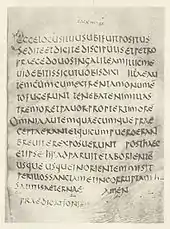Codex Bobiensis
Der Codex Bobiensis (Siglum k, Nr. 1 nach Beuron) ist eine Handschrift, die etwa um 400 entstand. Sie enthält den Text des Evangeliums des Markus 8.8–16.9 und den des Evangeliums nach Matthäus 1.1–15.36 in einer der frühesten Fassungen der Vetus Latina.

Der Text repräsentiert den afrikanischen Texttyp. Er war möglicherweise die Abschrift eines Papyrus aus dem 2. Jahrhundert. Er hat große Übereinstimmung mit Zitaten in den Schriften von Cyprian von Karthago im 3. Jahrhundert.
Die Handschrift endet nach Mark. 16.8 mit einem eigenen Schluss, die meisten anderen Handschriften enthalten noch die Verse 9-20. Nach Mark. 16.3 folgt nur in dieser Handschrift ein Zusatz: „ab osteo? Subito autem ad horam tertiam tenebrae diei factae sunt per totum orbem terrae, et descenderunt de caelis angeli et surgent (-ntes?, -nte eo?, surgit?) in claritate vivi Dei (viri duo? + et) simul ascenderunt cum eo, et continuo lux facta est. Tunc illae accesserunt ad monimentum.“.[1]
Die Handschrift befand sich in der Abtei Bobbio in Italien. Heute wird sie in der Biblioteca Nazionale in Turin, Signatur G VII 15 (ehem. CVII saec. IV), aufbewahrt.
Text
- Konstantin von Tischendorf: Wiener Jahrbücher, 1847.
- Adolf Jülicher, Walter Matzkow, Kurt Aland (Hrsg.). Itala: Das Neue Testament in altlateinischer Überlieferung. Walter de Gruyter, Berlin 1938–1972.
Literatur
- Bruce M. Metzger: The Text of the New Testament: Its Transmission, Corruption, and Restoration. 3. Auflage, Oxford University Press, New York 1992, S. 73.[2]
- F. H. A. Scrivener: A Plain Introduction to the Criticism of the New Testament for the Use of Biblical Students. 4. Auflage, Band II, George Bell and Sons, London 1894, S. 48.[3]
- John Wordsworth: Old Latin Biblical Texts. Clarendon Press, Oxford 1886 (online).
- F. C. Burkitt: Notes. Saint Mark XV in codex k. In: The Journal of Theological Studies, Band 1, 1900, S. 278 f. (online).
- F. C. Burkitt: Further Notes on codex k. In: The Journal of Theological Studies, Band 5, 1904, S. 100–107 (online).
- C. H. Turner: A Re-collation of Codex k. In: The Journal of Theological Studies, Band 5, 1904, S. 88–100 (online).
Weblinks
- Codex Bobiensis (englisch)
Anmerkungen
- Nach Eberhard Nestle, Erwin Nestle, Barbara Aland, Kurt Aland (Hrsg.): Novum Testamentum Graece. 26. Auflage, Deutsche Bibelgesellschaft, Stuttgart 1991, S. 146.
- The most important witness to the African Old Latin is codex Bobbiensis, to which the symbol k has been assigned. Unfortunately, it is quite fragmentary, containing only about half of Matthew and Mark. It was copied about A.D. 400 in Africa and brought to the Irish monastery of Bobbio in northern Italy, where it was preserved for many centuries until it found a home in the National Library at Turin, where it is now. Its form of text agrees very closely with the quotations made by St. Cyprian of Carthage (about A.D. 250). According to E.A. Lowe, k shows paleographical marks of having been copied from a second-century papyrus. It is noteworthy that k contains the intermediate ending of the Gospel according to Mark.
- (…) This MS. is perhaps the most important, in regard to text, of all the Old Latin copies, being undoubtedly the oldest existing representative of the African type. It contains Mark 8:8-11; 8:14-16; 8:19-16:9; Matthew 1:1-3:10; 4:2-14:17; 15:20-36 (…).